You're watching your standard forklift struggling up a gravel ramp, wheels spinning. The operator is frustrated, the entire job site has stopped to watch, waiting to see if it makes it.
The best forklift for a sloped construction site is a 4WD rough terrain forklift1. It provides the essential traction for climbing, stability against tipping, and controlled engine braking2 needed for safely descending hillsides and ramps.
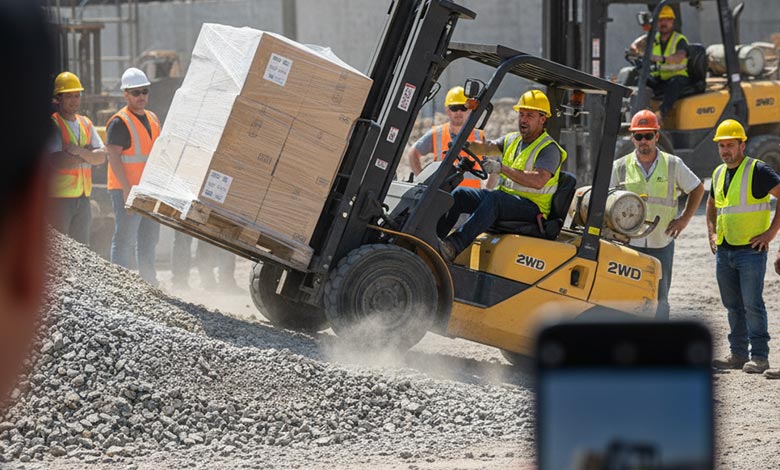
I've seen this exact scene play out hundreds of times. A project manager has a perfectly good 2WD forklift that works fine on the flat, but the moment it hits a slope, it feels like a totally different—and inadequate—machine. I've had clients tell me it feels like they lose 50% of the machine's performance on an incline. They're not wrong. It's not the operator's fault; the forklift simply isn't designed for that environment. The real problem is that the machine is constantly fighting the hill instead of working with it, which is not only inefficient but incredibly unsafe.
Why do standard forklifts fail on slopes?
You invested in a powerful forklift, but on a simple construction ramp, it can barely move. You're wondering why its impressive specs seem to disappear the second the ground isn't perfectly level.
A standard 2WD forklift3 fails because its design works against it on an incline. Weight shifts away from the front drive wheels, causing them to lose traction, while the steering becomes light and unresponsive.
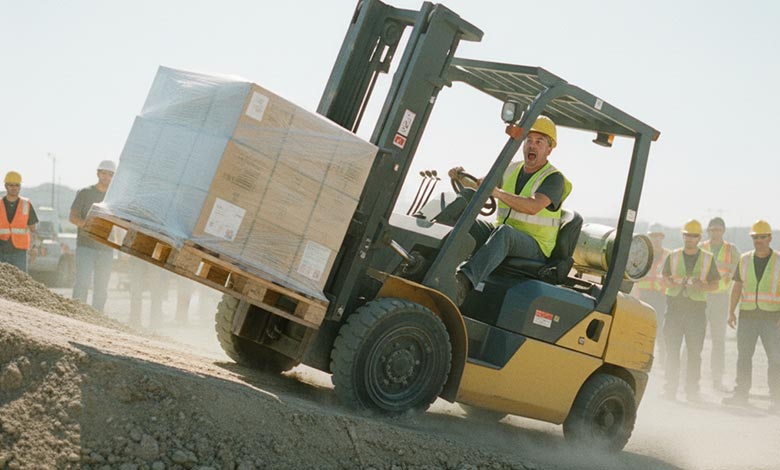
I always explain this to my clients using a simple visual. Imagine your front-wheel-drive car trying to go up a slippery hill; the effect is the same. The physics of the situation are actively working to defeat the machine.
Here's exactly what happens to a standard 2WD forklift as it starts to climb:
- Loss of Traction: The center of gravity shifts backward, lifting weight off the front drive wheels. They have less grip, so they spin on loose dirt or gravel. All that engine power becomes useless.
- Loss of Steering: As the rear wheels bear more weight, the steering axle gets light. The operator turns the wheel, but the machine barely responds, giving them a terrifying lack of control.
- Massive Power Loss: The engine isn't just lifting the load anymore; it's also fighting gravity. This enormous extra strain means a forklift rated to lift 3 tons on flat ground might struggle to move 1.5 tons up a slope.
It's a complete breakdown of the machine's core functions. It’s not a minor issue; it's a fundamental design flaw for that application.
Isn't going downhill the easy part?
You might think that once you're at the top, the hard part is over. Gravity is on your side now, so coming down should be simple, right?
No, downhill is far more dangerous. A standard forklift's brakes can be quickly overwhelmed by the momentum. On loose ground, even light braking can lock the wheels, causing the machine to slide or jack-knife.
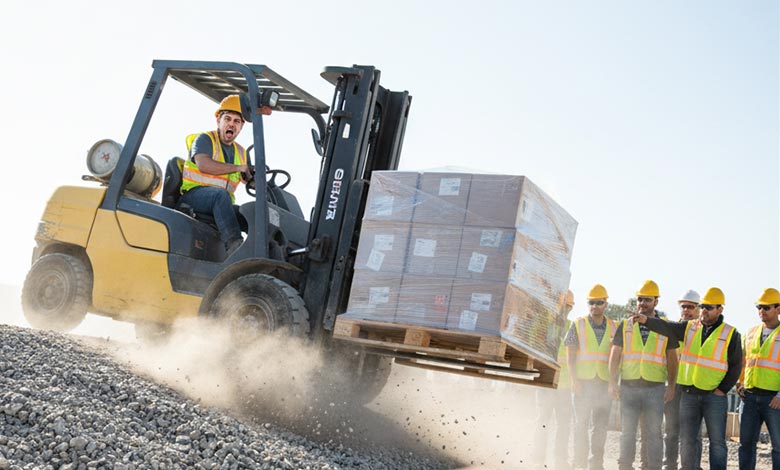
I can't stress this enough when I talk to site managers: most of the serious slope-related incidents4 I hear about happen on the way down. An operator told me it feels like the load is pushing the forklift down the hill, and he's right. He's not just steering a forklift anymore; he's trying to hold back a multi-ton battering ram.
Relying solely on the brakes is a recipe for disaster. They heat up fast, which can lead to brake fade5 or complete failure. Even worse, on a gravel or dirt slope, a jab at the brakes can cause the forklift to slide sideways, which is a direct path to a rollover. You are no longer in control; physics is. This is where a machine designed for rough terrain becomes not just a better choice, but the only safe one.
What makes 4WD the right choice for traction?
You've seen your 2WD forklift spin its wheels, and you know you need more grip. You're wondering if 4WD is just a nice feature or if it fundamentally solves the problem.
4WD solves the core problem of traction loss6 on slopes. By powering all four wheels, it ensures that even as weight shifts7 to the rear, the machine has wheels with plenty of grip to keep pushing forward.
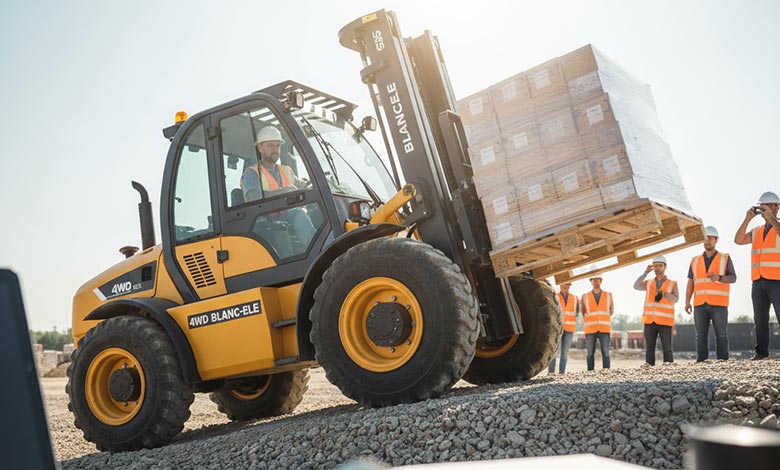
This is the number one reason I recommend 4WD models8 for any site that isn't perfectly flat. It entirely changes the dynamic between the machine and the slope. Instead of fighting against physics, the forklift starts using physics to its advantage.
Let's compare the experience directly:
| Scenario | 2WD Forklift Experience | 4WD Rough Terrain Forklift Experience |
|---|---|---|
| Starting on a Slope | The front drive wheels spin. The operator has to try and "rock" the machine or get a running start, which is unsafe. | All four wheels bite into the ground. The forklift moves forward smoothly and confidently, even from a dead stop. |
| Climbing a Gravel Ramp | The front wheels lose grip on loose stones. The machine lurches, the load shifts, and the operator loses control of the steering. | The front and rear wheels work together. If one set slips slightly, the other maintains forward momentum. The climb is stable and predictable. |
With 4WD, your operator isn't constantly battling for grip. They can focus on positioning the load and navigating the site safely.
Is it just about having four-wheel drive?
You're convinced that 4WD is necessary, but you're wondering if that's the only feature that matters. Are there other parts of a "rough terrain" forklift that are just as important?
No, it's a complete system. True rough terrain forklifts also have higher ground clearance9 to navigate obstacles, aggressive tire treads10 for grip, and an articulated chassis11 for stability on uneven ground.

I've had people ask if they could just put better tires on their 2WD forklift. The answer is no, because you're missing the other critical components that work together. A purpose-built rough terrain machine is more than just its drivetrain.
Here are the other key elements:
- Aggressive Tires: These have deep, wide treads designed to bite into soft dirt, mud, and gravel, not just roll on concrete.
- High Ground Clearance: This allows the forklift to drive over rocks, ruts, and debris without getting stuck or damaging the undercarriage. A standard forklift would be stopped cold.
- Enhanced Stability: Rough terrain models are often built with a wider stance and a lower center of gravity to resist tipping on uneven surfaces.
- Robust Drivetrain: The transmission and axles are engineered to handle the immense torque and stress of operating on difficult terrain, which brings us to the next critical point.
You're not just buying 4WD; you're investing in a machine where every component is designed for the harsh reality of a construction site.
How does it solve the dangerous downhill problem?
You understand how 4WD helps with going uphill. But what about the far scarier problem of a runaway forklift going downhill? How does the right machine prevent that?
A 4WD rough terrain forklift1 solves this with its drivetrain. By shifting into a low gear, the operator engages powerful engine braking, which keeps the descent slow and controlled without ever needing to touch the brakes.
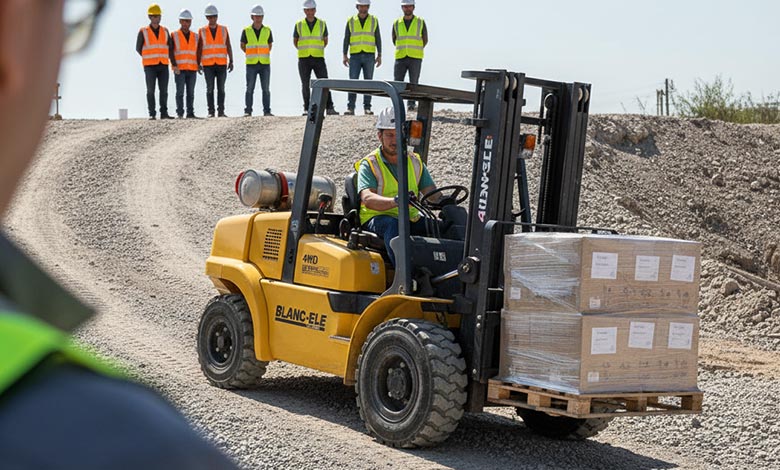
This is the safety feature that I believe is most overlooked, yet most important. When I explain this to clients, I tell them to stop thinking about the brakes. On a proper machine, the brakes are only for coming to a final stop. The engine and transmission do all the heavy lifting of controlling your speed.
Here's the difference it makes: The operator selects a low gear at the top of the hill. As the forklift starts to roll, the transmission restricts its speed, holding it at a steady, manageable pace—like walking speed. There is no uncontrolled acceleration. No panic braking. No risk of skidding. The operator simply steers. This transforms the most dangerous part of the job into the most controlled. It gives your operator the confidence to do the job safely and efficiently.
Conclusion
For sloped construction sites, a 4WD rough terrain forklift1 is not a luxury. It’s the essential tool for safety, productivity, and preventing damage from using the wrong equipment.

Explore how 4WD forklifts enhance safety and efficiency on sloped construction sites. ↩
Explore the benefits of engine braking for safe downhill forklift operation. ↩
Learn why 2WD forklifts are inadequate for sloped terrains and what alternatives exist. ↩
Learn about the risks associated with forklifts on slopes and how to mitigate them. ↩
Learn about brake fade and its implications for safety on sloped surfaces. ↩
Understanding traction loss can help you choose the right equipment for your job site. ↩
Discover the physics behind weight shifts and their impact on forklift operation. ↩
Explore the key benefits of 4WD forklifts for construction sites with slopes. ↩
Discover how ground clearance impacts forklift performance on uneven surfaces. ↩
Learn how tire design affects traction and stability on rough terrains. ↩
Understand how an articulated chassis enhances stability on uneven ground. ↩
